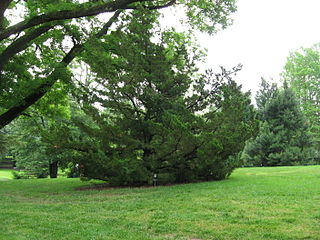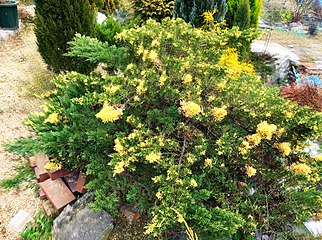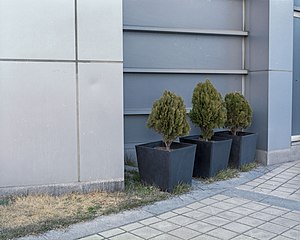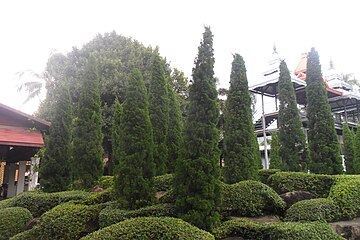| This article needs additional citations for verification. Please help improve this article by adding citations to reliable sources. Unsourced material may be challenged and removed. Find sources: "Juniperus chinensis" – news · newspapers · books · scholar · JSTOR (November 2020) (Learn how and when to remove this message) |
| Juniperus chinensis | |
|---|---|

| |
| Chinese juniper shoot, showing juvenile (needle-like) leaves, adult scale leaves, and young male cones | |
| Conservation status | |
 Least Concern (IUCN 3.1) | |
| Scientific classification | |
| Kingdom: | Plantae |
| Clade: | Tracheophytes |
| Clade: | Gymnospermae |
| Division: | Pinophyta |
| Class: | Pinopsida |
| Order: | Cupressales |
| Family: | Cupressaceae |
| Genus: | Juniperus |
| Section: | Juniperus sect. Sabina |
| Species: | J. chinensis |
| Binomial name | |
| Juniperus chinensis L. | |
Juniperus chinensis, the Chinese juniper, is a species of plant in the cypress family Cupressaceae, native to China, Myanmar, Japan, Korea and the Russian Far East. Growing 1–20 metres (3+1⁄2–65+1⁄2 feet) tall, it is a very variable coniferous evergreen tree or shrub.
A variety of Juniperus chinensis referred to as "Shimpaku" is one of the top species used in the Japanese art of bonsai. Among the multiple cultivars of Shimpaku found in Japan, the most desirable due to its tight, fine foliage and excellent growing habits, is the "Itoigawa" variety.

Growth
The leaves grow in two forms, juvenile needle-like leaves 5–10 millimetres (1⁄4–3⁄8 inch) long, and adult scale-leaves 1.5–3 mm long. Mature trees usually continue to bear some juvenile foliage as well as adult, particularly on shaded shoots low in the crown. This species is often dioecious (either male or female plants), but some individual plants produce both sexes of flowers. The blue-black berry-like cones grow to 7–12 mm in diameter, have a whitish waxy bloom, and contain 2–4 seeds; they mature in about 18 months. The male cones, 2–4 mm long, shed their pollen in early spring.
Cultivation and uses
This popular ornamental tree or shrub for gardens, parks, and in tough coastal conditions of hot sun and sandy fast-draining soils, has more than 100 named cultivars selected for various characteristics, such as yellow foliage (e.g. cvs. 'Aurea', 'Tremonia'), permanently juvenile foliage (e.g. cv. 'Shoosmith'), columnar crown shape (cv. 'Columnaris'), abundant cones, spiral branch pattern (e.g. cv. 'Kaizuka'), etc. First popular in the United States in the Los Angeles gardens in Mediterranean style homes, and now commonly found along both the West and East Coast in beach and coastal areas.
The Chinese juniper is widely used in bonsai, both as individual plants, such as the 250-year-old "Omiya tree" in the Birmingham Botanical Gardens in the UK, and in groups, such as the well-known Goshin on display at the National Bonsai and Penjing Museum at the US National Arboretum. The cultivar 'Shimpaku' is a very important bonsai subject.
AGM cultivars
The following cultivars have gained the Royal Horticultural Society's Award of Garden Merit:
- 'Aurea' (golden Chinese juniper)
- 'Blaauw'
- 'Grey Owl'
- 'Kaizuka'
- 'Plumosa Aurea'
- 'Pyramidalis'
Juniperus × pfitzeriana
The hybrid between Juniperus chinensis and Juniperus sabina, known as Juniperus × pfitzeriana (Pfitzer juniper, synonym J. × media), is also very common as a cultivated plant. This hybrid grows only as a shrub, never a tree, making it suitable for smaller gardens:
- 'Old Gold'
- 'Sulphur Spray'
Gallery
-

-
 As a 250-year-old bonsai in the Birmingham Botanical Gardens
As a 250-year-old bonsai in the Birmingham Botanical Gardens
-
-
 J. × pfitzeriana 'Old Gold'
J. × pfitzeriana 'Old Gold'
-
 J. chinensis 'Expansa Variegata'
J. chinensis 'Expansa Variegata'
-

-
 Juniperus chinensis var. kaizuka
Juniperus chinensis var. kaizuka
References
- ^ Farjon, A. (2013). "Juniperus chinensis". IUCN Red List of Threatened Species. 2013: e.T42227A2962948. doi:10.2305/IUCN.UK.2013-1.RLTS.T42227A2962948.en. Retrieved 19 November 2021.
- "What the HECK is a Shimpaku Juniper? | Bonsai-U". YouTube. 23 July 2020.
- "AGM Plants - Ornamental" (PDF). Royal Horticultural Society. July 2017. p. 56. Retrieved 14 March 2018.
- "RHS Plant Selector Juniperus chinensis 'Aurea' AGM / RHS Gardening". Apps.rhs.org.uk. Retrieved 2020-09-16.
- "RHS Plant Selector Juniperus chinensis 'Blaauw' AGM / RHS Gardening". Apps.rhs.org.uk. Retrieved 2020-09-16.
- "RHS Plant Selector Juniperus 'Grey Owl' AGM / RHS Gardening". Apps.rhs.org.uk. Retrieved 2020-09-16.
- "RHS Plant Selector Juniperus chinensis 'Kaizuka' AGM / RHS Gardening". Apps.rhs.org.uk. Retrieved 2020-09-16.
- "RHS Plant Selector Juniperus chinensis 'Plumosa Aurea' AGM / RHS Gardening". Apps.rhs.org.uk. Retrieved 2020-09-16.
- "RHS Plant Selector Juniperus chinensis 'Pyramidalis' AGM / RHS Gardening". Apps.rhs.org.uk. Retrieved 2020-09-16.
- ' "Juniperus × pfizeriana 'Old Gold'". RHS. Retrieved 26 September 2020.
- "Juniperus × pfizeriana 'Sulphur Spray'". RHS. Retrieved 26 September 2020.
| Taxon identifiers | |
|---|---|
| Juniperus chinensis |
|
